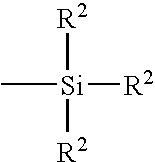Process for preparing a silica rubber blend
- Summary
- Abstract
- Description
- Claims
- Application Information
AI Technical Summary
Benefits of technology
Problems solved by technology
Method used
Image
Examples
example 1
[0049] In this experiment a silica / rubber blend was made utilizing the technique of this invention and compared to a silica / rubber blend made by a convention dry mixing technique. In the procedure used a silica slurry was made by mixing silica powder, a silica coupling agent, and a low molecular weight TEOS functionalized polybutadiene rubber into hexane at 60° C. for 2 hours. The TEOS functionalized polybutadiene rubber had a number average molecular weight of between 105,000 and 165,000. It also had a glass transition temperature of about −19° C. to −25° C.
[0050] The silica slurry containing the silica coupling agent and the low molecular weight end-group functionalized rubber was then mixed into a cement of Solflex® 2535 styrene-butadiene rubber having a solids content of 15 percent at 60° C. for 2 hours. The rubber cement was subsequently steam stripped to recover the silica / rubber blend from the hexane solvent. The silica / rubber blend recovered had a particle size of 30-150 me...
example 2
[0053] The procedure employed in Example 1 was repeated in this experiment except that a low molecular weight TEOS functionalized polybutadiene rubber having a molecular weight within the range of 95,000 to 170,000 and a glass transition temperature of −95° C. was used instead of the low molecular weight end-group functionalized styrene-butadiene rubber employed in Example 1. The silica / rubber sample was then compounded and compared to a control as was done in Example 1. The physical properties of the experimental sample and the control are shown in Table II.
TABLE IIPropertySolution BlendControlImprovementTan δ0.0920.10210.7%G′50% / G′1%0.520.4321.5%Tensile (mPa)20.020.23 −1%Elongation389%400% −3%M300% / M100%5.54.5 22%Power (mKg-m)12.414.4 14%
[0054] As can be seen the silica / rubber blend made utilizing the technique of this invention (solution blend) again exhibited significantly better modulus than did the control. It also significantly required less power to formulate in the ...
PUM
| Property | Measurement | Unit |
|---|---|---|
| Temperature | aaaaa | aaaaa |
| Temperature | aaaaa | aaaaa |
| Temperature | aaaaa | aaaaa |
Abstract
Description
Claims
Application Information
 Login to View More
Login to View More - R&D
- Intellectual Property
- Life Sciences
- Materials
- Tech Scout
- Unparalleled Data Quality
- Higher Quality Content
- 60% Fewer Hallucinations
Browse by: Latest US Patents, China's latest patents, Technical Efficacy Thesaurus, Application Domain, Technology Topic, Popular Technical Reports.
© 2025 PatSnap. All rights reserved.Legal|Privacy policy|Modern Slavery Act Transparency Statement|Sitemap|About US| Contact US: help@patsnap.com


